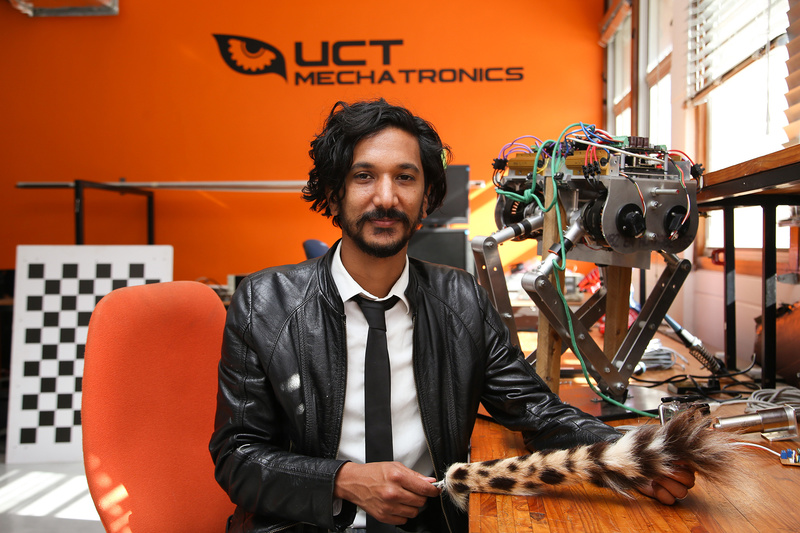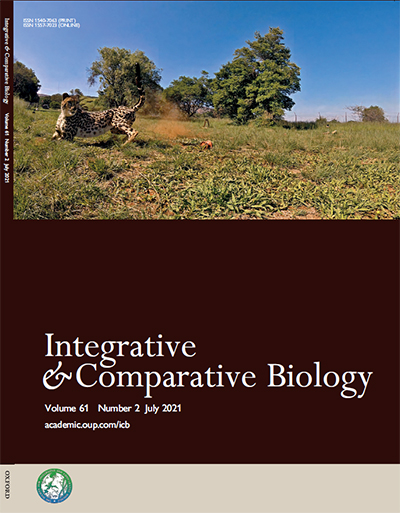Amir Patel – moving like a cheetah
04 November 2021 | Story Robert Morrell. Read time 5 min.
Amir Patel in the Department of Electrical Engineering at the University of Cape Town’s (UCT) Faculty of Engineering & the Built Environment has been following in the footsteps of the cheetah. This fast-moving and endangered hunter has inspired Amir’s research in robotics. But it is also a metaphor for Amir’s progress as he bounds from one great idea and achievement to the next.
Amir Patel’s research on cheetahs and especially their tails has been pathbreaking in understanding movement and stability in animals. Amir has used his findings in robot-design. His innovative work was recently rewarded by receiving an award from the UCT College of Fellows as a Young Researcher for 2021. The award is granted annually to young academics at UCT to support their demonstrated ability of making a significant contribution to their field and is intended for research purposes.
“I believe we are students of problems, not disciplines. Understanding the cheetah requires me to have an unconstrained skillset.”
In 2021 he was rated Y1 by the NRF and was named as one of only two Africans (Dr Mohohlo Tsoeu being the other) to receive the Google Research Scholar Program award, which is focused on funding world-class research conducted by early-career professors.
Robotics and locomotion

Amir was selected for his novel work where he uses robotics to understand the locomotion of animals. He utilises techniques such a sensor fusion, optimal control and physical experiments to understand the neuromechanics of manoeuvrability and is particularly interested in studying the cheetah (Acinonyx jubatus), the fastest terrestrial animal. This is quite a challenging problem and has already resulted in 20 papers in the top five Robotics ad Computer Vision publications. He has also made an impact in the biology field, with a co-authored paper in Nature Protocols and a cover photo in the journal of Integrative & Comparative Biology (ICB). ICB is one of the premier biology journals and his work was showcased as it is pushing the field of biomechanics beyond the confines of the lab. In particular, Amir’s group utilised deep learning to reconstruct the motion of the cheetah while it is rapidly manoeuvring, which has provided insight on the role of the animal’s tail for balance.
His novel sensing work has resulted in two sensor patents with applications in human biomechanics. These have resulted in funding and support from the UCT Research Contracts and Innovation division, as well as the University Technology Fund (UTF). Alongside his Next Generation Professoriate (NGP) colleague Dr Yumna Albertus, he is about to launch a spin-out company (Acino Technologies) which will be the vehicle to market these systems to sports scientists and clinicians. Neurological and orthopaedic rehabilitation is still out of reach for most South Africans as the required equipment (which provide data from patients before, during and after interventions) is prohibitively expensive and currently available only at biomechanics research laboratories and specialised centres. This is unfortunate for South Africa, where as an example, the incidences of traumatic spinal cord injury (TSCI) is three times the global rate, with 60% of cases attributed to assault.
All biomechanical innovations and systems have shortcomings and should not simply be copied and made “cheaper”. Amir is inspired by the Global Health movement which is an area of study, research and practice that places a priority on improving health and achieving equity in health for all people worldwide. He aims to start a new movement of Global Biomechanics, which, akin to Global Surgery, will make high-quality rehabilitation accessible and affordable to communities. He aims to do this by re-imagining biomechanic sensing, which will not only make these systems radically cheaper, but more effective than current sensing methods.
Next step – detecting disease in animals
Amir has set his sights on a new trans-disciplinary venture which brings together the fields of ecology, artificial intelligence (AI) and robotics to solve an important global health problem: the inability to effectively monitor the health status of wildlife. The COVID-19 pandemic has starkly highlighted the interconnectedness of animal, human and environmental health (a concept known as One Health), pandemics due to spillover of animal diseases into humans. This connection has in fact been known to have existed for centuries. According to the Food and Agriculture Organization of the United Nations, 70% of the new diseases that have emerged in human beings in recent decades are of animal origin. Amir believes that his expertise in robotics and AI can be utilised to develop new systems which can swiftly detect a disease in a wild animal population before it spreads across the eco-system or to humans.
 This work is licensed under a Creative Commons Attribution-NoDerivatives 4.0 International License.
This work is licensed under a Creative Commons Attribution-NoDerivatives 4.0 International License.
Please view the republishing articles page for more information.






